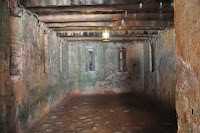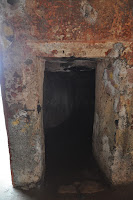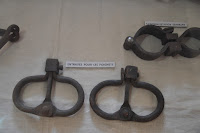(...)
Outside the House of the Slaves, where there was already quite a huge queue, stood a statue personifying two sibling slaves standing on a djembé.
Aly and I managed to get in with the second group and from then on I was referred to a Museum guide, a rather old toothless man whose powerful and expressive words had me mesmerised. He was a brilliant communicator, who made sure I got to know everything that I possibly could in such a short visit.
The House of the Slaves was built by the Dutch in 1776 being the last slave house to date in Gorée. Men, women and children slaves had to wait for long periods which could last up to three months before being taken aboard the slave trading ships. Most families were separated, once their fate was entirely on the hands of the buyers. Major destinations were Louisiana in the USA, Brazil, Cuba, Haiti and West Indies.
Children were literaly "stored" in one of the many small cells. Their mortality rate is said to have been the highest in the House. As there were no birth certificates their ages were determined as in accordance with their dentition.
The 2,6 m by 2,6 metre cells reserved for men housed up to 15 to 20 people seated with their backs against the wall and chained aorund the neck and arms. They were just released once a day to satisfy their needs. Because of the revolting hygienic conditions the detainees were submitted to, the first epidemic pest is said to have ravaged the island in 1779.
Because the men's value was based on their weight, some of the temporarily unfit male slaves (weighing less than 60 kg - the minimum accepted weight) were kept in separate cells and "fattened" with locally grown beans referred to in Senegal as Niebe.
I was particularly impressed with the size of the cells taking into account the number of people "accomodated" in them, but more so with the punishment cells for recalcitrant detainees because of the exiguous space and the humidity.
Young girls were separated from the women because of the price which was dependant on the size and state of the breasts, not to mention their virginity. Some of the young girls' salvation lied on giving themselves to the slave traders in order to be later granted freedom, once they got pregnant they would be dropped at Gorée.The mixed-race girls (born from the union between slave traders and their young slave concubines) were commonly called "Signare" (a deformation of the Portuguese noun Senhora, standing for lady), and ended up forming the aristocracy of Gorée.
The punishment cell


The corridor leading to the gate of no return (because once the slaves left through that gate leading into the sea it was their definite farewell to Africa), outside of which a wharf made of palm wood was used as loading dock.
It is said many slaves attempted to escape throughout the "loading" process by plunging into the sea,with very limited possibilities of escape and eventual survival though, because they were either shot by the guards or devoured by the abundant number of sharks.
The visit continued onto the upper floor, where a slavery Museum has been installed providing precious information and images regarding the slavery trade and events therewith related.
I believe anyone visiting this House will be impressed and ponder what went on in these premises and similar ones along the coast. I felt "nauseated" during some parts of the visit and I can imagine how infinitely harder it must be for Afro Americans and any Afro descendents to visit this house, this being the reason as to why I can't help but quote Boubacar Joseph Ndiaye:
"Se souvenir de son passé pour reconstruire sa dignité"
"Qu'en ce lieu où la dignité humaine fut malmenée qu'il nous revienne la nécessité de faire l'homme qui reste à faire."



























No comments:
Post a Comment